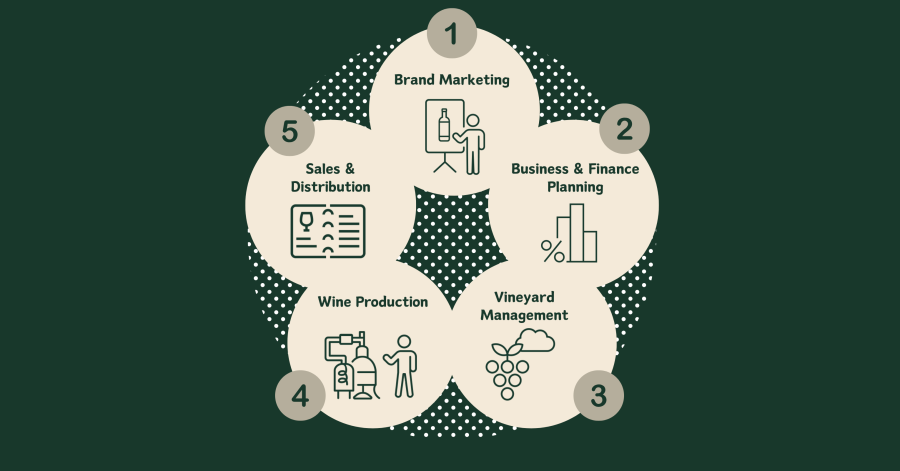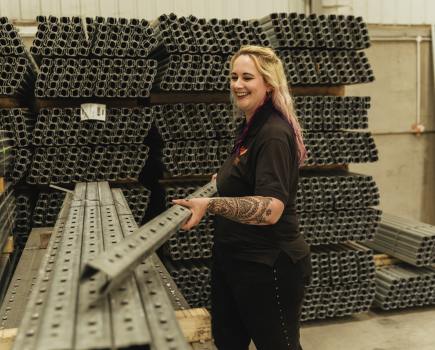While establishing vines may seem like a straightforward step, crafting a thriving brand requires rigorous planning, foresight, and creativity.
Determining your customer base, forecasting profitability, and anticipating market trends requires strategic business, brand and financial planning. Every decision you make will help unlock the full potential of your business for years to come.
Brand marketing
The size of your vineyard, type of grape varieties and clones will determine the wine style and quantity of wine you can produce. Arguably, the wine you make should actually be determined by the market. This means it is often best to have your brand position and marketing plan in place before you plant.
Building a brand and the infrastructure you need for consumer engagement requires investment. Creating customer experiences like a cellar door or wine tours, customer loyalty systems and wine clubs, visual branding and packaging, as well as digital communication tools and content, all contribute to a wine brand’s success.
Marketing and brand specialist Kerrie Lyons said, “With the drink market becoming increasingly fragmented and wine consumption patterns changing, knowing who your customer is and tapping directly into cultural trends gives wine producers the best opportunity to carve out a niche in the market.
“Investing in market research and a brand strategy which reflects consumer values and expectations, means the business responds proactively to consumer demand rather than relying on the status quo.”
Business and financial planning
Vinescapes CEO, Dr Alistair Nesbitt said creating a business and investment plan has been vital to the success and growth of Vinescapes.
“In our business, we know the skills and experience we need and have a solid plan in place to reach our goals and objectives,” he said.
Alistair’s work with winegrowers has given him direct experience of the opportunities and risks facing vineyard owners.
“When businesses don’t plan sufficiently, it can impact directly on the level of continued investment available for the vineyard or to process the wine, impacting on sales, stock holding and ultimately profitability.
“Our key message is to undertake initial and regular business planning to ensure the business has a clear path to success and can take advantage of the opportunities that arise.”
On-going vineyard investment
This year’s vintage set out just how essential it is for vineyard owners to continually invest in their vineyard, as this provides critical protection against the unpredictability of extreme weather and shifting seasonal conditions.
Vinescapes viticulturist Joel Jorgensen said, “The best fruit harvested in 2024 was found across vineyards where adequate investment was made to mitigate disease pressures.
“Running costs were higher than normal this growing season. It required a firm commitment to shoot or bunch thin at precisely the right time, invest in resource traps for SWD, and apply the appropriate sprays across every block to protect bunches from spoilage and rot.”
Wine production, sales and distribution
A hectare of grapes produces approximately 5-6,000 bottles of wine per annum. Access to a winery with the capacity to process the right tonnage is essential. Contract winemaking is a feasible option for many winegrowers, however long-term returns are more favourable to those who build and equip an on-site winery, depending on scale.
Beyond production, storage, logistics and selecting the right distribution method to get your wine to wholesale clients or export markets can be costly. Through budget forecasting and a phased investment plan, these elements of the business can grow as your business grows.
Grape contracting
Another option for growers is to sell grapes to winemakers on contract. If so, experience suggests it is best to conduct contract negotiations with potential buyers well in advance of harvest to gain the best return on investment.
Certified accountant and financial manager, Paula Nesbitt said, “We estimate the price of grapes on the spot market to be approximately £2,500 per tonne for common varieties like pinot noir or chardonnay. Yet we do see prices vary year-to-year depending on the season, fruit quality and yield, which can change on the cusp of harvest. This risk to income where sales contracts are not in place is an important factor every winegrower needs to prepare and plan for.”
If you would like support with your investment and acquisition plan, get in touch with Paula Nesbitt ACCA, to find out how Vinescapes can help.
For more like this, sign up for the FREE Vineyard newsletter here and receive all the latest viticulture news, reviews and insight




